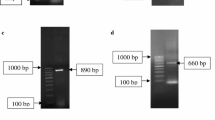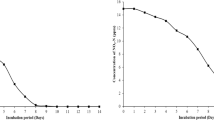Abstract
Nitrite is a well-known toxicant in aquaculture, produced as intermediate in nitrification. Two nitrite-oxidizing bacterial consortia, one from marine environment and the other from brackish water, were developed by enrichment technique at National Centre for Aquatic Animal Health, for removal of nitrite from recirculating aquaculture systems. In the present study, bacterial diversity of the consortia was assessed based on 16S ribosomal RNA and the functional gene analysis. Clone libraries of 16S ribosomal RNA gene and nitrite oxidoreductase A gene were constructed, and amplified ribosomal DNA restriction analysis was carried out to cluster the clones. Dendrograms generated through molecular characterization showed 29 and 27 clusters in marine and brackish water consortia, respectively. Phylogenetic analyses of representative clones from each cluster depicted profound diversity in the consortia consisting autotrophic nitrifiers belonging to Proteobacteria, anaerobic ammonia oxidizers, Actinobacteria, Bacteroidetes and heterotrophic denitrifiers. Functional gene analysis corroborated with the presence of specific nitrite oxidizers. Quantitative polymerase chain reaction showed the abundance of nitrite oxidizers in the order of 1.51 ± 0.38 × 109/g and 4.88 ± 0.42 × 107/g in marine and brackish water consortia, respectively. Diversity indices and pattern of distribution of organisms within the consortia were analyzed using Geneious, VITCOMIC, Mega 5 and Primer software. The marine nitrite-oxidizing consortium showed higher Shannon–Wiener diversity and mean population diversity than brackish water consortium, suggesting that the former was having more diverse flora and higher potential to be used as startup cultures for activating nitrifying bioreactors subsequent to acclimatization to the required salinity.








Similar content being viewed by others
References
Abeliovich A (2006) The nitrite oxidizing bacteria. In: Dworkin M et al (eds) The prokaryotes, vol 5. Springer, New York, pp 861–872
Achuthan C, Kumar VJR, Manju NJ, Philip R, Singh ISB (2006) Development of nitrifying bacterial consortia for immobilizing in nitrifying bioreactors designed for penaeid and non-penaeid larval rearing systems in the tropics. Indian J Mar Sci 35:240–248
Altschul SF, Gish W, Miller W, Myers EW, Lipman DJ (1990) Basic local alignment search tool. J Mol Biol 215:403–410. doi:10.1016/S0022-2836(05)80360-2
Burrell PC, Keller J, Blackall LL (1998) Microbiology of a nitrite oxidizing bioreactor. Appl Environ Microbiol 64:1878–1883
Chao A, Chazdon RL, Colwell RK, Shen TJ (2006) Abundance based similarity indices and their estimation when there are unseen species in samples. Biometrics 62:361–371
Chen JC, Chen SF (1992) Effects of nitrite on growth and molting of Penneus monodon juveniles. Comp Biochem Phys 101:453–458
Clarke KR, Gorley RN (2015) PRIMER v7: user manual/tutorial, PRIMER-E., Plymouth, p 296
Cua LS, Stein LY (2011) Effects of nitrite onammonia-oxidizing activity and gene regulation in three ammonia-oxidizing bacteria. FEMS Microbiol Lett 319:169–175
de los Reyes FL (2010) Challenges in determining causation in structure–function studies using molecular biological techniques. Water Res 44:4948–4957
Doxtader KG, Alexander M (1965) Nitrification by heterotrophic soil microorganisms. Am Soc Agron 30:351–355
Kumar VJR, Achuthan C, Manju NJ, Philip R, Singh ISB (2009a) A stringed bed suspended bioreactor (SBSBR) for in situ nitrification in penaeid and non penaeid hatchery systems. Aquac Int 17:479–489. doi:10.1007/s10499-008-9218-2
Kumar VJR, Achuthan C, Manju NJ, Philip R, Singh ISB (2009b) Activated packed bed bioreactors (PBBR) for the rapid nitrification in brackish water hatchery systems. J Ind Microbiol Biot 36:355–365. doi:10.1007/s10295-008-0504-9
Kumar VJR, Joseph V, Philip R, Singh ISB (2010) Nitrification in brackish water recirculating aquaculture system integrated with activated packed bed bioreactor. Water Sci Technol 61:797–805. doi:10.2166/wst.2010.849
Lipschultz F, Zafiriou OC, Wofsy SC, McElroy MB, Valois FW, Watson SW (1981) Production of NO and N2O by soil nitrifying bacteria. Nature 294:641–643
Manju NJ, Deepesh V, Achuthan C, Rosamma P, Singh ISB (2009) Immobilization of nitrifying bacterial consortia on wood particles for bioaugmenting nitrification in shrimp culture systems. Aquaculture 294:65–75
Mori H, Maruyama F, Kurokawa K (2010) VITCOMIC: visualization tool for taxonomic compositions of microbial communities based on 16S rRNA gene sequences. BMC Bioinform 11:332
Ondov BD, Bergman NH, Phillippy AM (2011) Interactive metagenomic visualization in a Web browser. BMC Bioinform 12(1):385
Poly F, Wertz S, Brothier E, Degrange V (2007) First exploration of Nitrobacter diversity in soils by a PCR cloning-sequencing approach targeting functional gene nxrA. FEMS Res Artic 63:132–140
Reddy GSM, Aggarwal RK, Matsumotto GI, Sivaji SI (2000) Arthrobacter flavus sp. nov., a psycrophilic bacterium isolated from a pond in McMurdo Dry Valley, Antarctica. Int J Syst Evol Microbiol 50:1553–1561
Sánchez O, Ferrera I, González JM, Mas J (2013) Assessing bacterial diversity in a seawater-processing wastewater treatment plant by 454-pyrosequencing of the 16S rRNA and amoA genes. Microbial Biot 6:435–442
Sorokin DY, Lücker S, Vejmelkova D, Kostrikina NA, Kleerebezem R, Rijpstra WIC, Damsté JSS, Le Paslier D, Muyzer G, Wagner M, Loosdrecht MCM, Daims H (2012) Nitrification expanded: discovery, physiology and genomics of a nitrite-oxidizing bacterium from the phylum Chloroflexi. ISME J 6:2245–2256
Tal Y, Watts JEM, Schreier SB, Sowers KR, Schreier HJ (2003) Characterization of the microbial community and nitrogen transformation processes associated with moving bed bioreactors in a closed recirculated mariculture system. Aquaculture 215:187–202
Tamura K, Peterson D, Peterson N, Stecher G, Nei M, Kumar S (2011) MEGA5: molecular evolutionary genetics analysis using maximum likelihood, evolutionary distance, and Maximum Parsimony methods. Mol Biol Evol 28:2731–2739. doi:10.1093/molbev/msr121
Ward BB, Voytek MA, Witzel K-P (1995) Phylogenetic diversity of natural populations of ammonia oxidizers investigated by specific PCR amplifications. Microbial Ecol 33:87–96
Wietz M, Hall MR, Hoj L (2009) Effects of seawater ozonation on biofilm development in aquaculture tanks. Syst Appl Microbiol 32:266–277
Acknowledgements
The first author acknowledges Department of Science and Technology (DST) under INSPIRE Scheme with Grant Number IF10193 for the Fellowship and Cochin University of Science and Technology for the support.
Author information
Authors and Affiliations
Corresponding author
Additional information
Editorial responsibility: S.R. Sabbagh-Yazdi.
Electronic supplementary material
Below is the link to the electronic supplementary material.
Fig. 1
Dendrogram of marine nitrite-oxidizing consortium (NIOPCU-1) on the basis of ARDRA (TIFF 29 kb)
Fig. 2
Dendrogram of brackish water nitrite-oxidizing consortium (NIONPCU-1) on the basis of ARDRA (TIFF 28 kb)
Fig. 3
Phylogenetic analysis of the 16S rRNA gene sequences from marine nitrite-oxidizing consortium (NIOPCU-1) (indicated using Δ) with the matched sequences from GenBank database by using Mega 5.0 software (TIFF 12188 kb)
Fig. 4
Phylogenetic analysis of the 16S rRNA gene sequences from brackish water nitrite-oxidizing consortium (NIONPCU-1) (indicated using Δ) with the matched sequences from GenBank database by using Mega 5.0 software (TIFF 11518 kb)
Fig. 5
Mean diversity in entire population of marine (NIOPCU-1) and brackish (NIONPCU-1) water nitrite-oxidizing consortia (XLSX 11 kb)
Fig. 6
Species richness evenness and dominance observed in marine nitrite-oxidizing consortium (NIOPCU-1) (XLSX 10 kb)
Fig. 7
Species richness evenness and dominance observed in brackish water nitrite-oxidizing consortium (NIONPCU-1) (XLSX 10 kb)
Fig. 8
Shannon–Wiener diversity index observed in marine (NIOPCU-1) and brackish (NIONPCU-1) water nitrite-oxidizing consortia (XLSX 10 kb)
Fig. 9
Copy number of nor A gene present in marine (NIOPCU-1) and brackish (NIONPCU-1) water nitrite-oxidizing consortia determined using quantitative PCR (XLSX 11 kb)
Rights and permissions
About this article
Cite this article
Preena, P.G., Kumar, V.J.R., Achuthan, C. et al. Diversity of marine and brackish water nitrite-oxidizing consortia developed for activating nitrifying bioreactors in aquaculture. Int. J. Environ. Sci. Technol. 15, 2399–2410 (2018). https://doi.org/10.1007/s13762-017-1580-z
Received:
Revised:
Accepted:
Published:
Issue Date:
DOI: https://doi.org/10.1007/s13762-017-1580-z




